 Front Range, Eastern Slope, Rocky Mountains
Front Range, Eastern Slope, Rocky Mountains

Tom Schweich
 Front Range, Eastern Slope, Rocky Mountains
Front Range, Eastern Slope, Rocky Mountains
| Checklist Flora of Native and Naturalized Vascular Plants of Golden and Vicinity, Jefferson County, Colorado |

|
Tom Schweich |

Topics in this Article: Introduction Geography History of Botanic Exploration and Publication Useful Publications Methods Results Discussion - Native Plants Discussion - Non-Native Plants Conclusion Acknowledgements Literature Cited Appendices |
Golden, Colorado sits in a valley formed by erosion along the Golden fault, the geotectonic boundary between the North American Cordillera and the Great Plains. Somewhat like Mono Lake, for which I have also prepared a checklist flora, it sits at a boundary, or perhaps ecotone. Things are always more interesting at the boundaries. I started this project when I realized no such list had been prepared for my newly adopted city. I hope you find this checklist flora helpful. Please write to me if you have questions or comments. | ||||||||||||||||||||||||||
|
|
IntroductionThis is a local flora for the City of Golden and immediate vicinity. The purpose is to catalog the plants that are found there, indicating areas where they may be found. The flora was developed from online databases of plant collections, plant collections by the author, and observations of plants when collections were impractical. Most of the collections or observations were made in open spaces, either those of the City of Golden or Jefferson County Open Space. In some cases, collections were made or observations recorded in city parks, especially in the natural areas of those parks. | ||||||||||||||||||||||||||
| |||||||||||||||||||||||||||
|
It is probably fair to ask why one would prepare a local flora. There are many sources of information about plant names, their descriptions, and how to identify them. There are numerous published floras for the whole state of Colorado, Colorado east slope and west slope, and the Intermountain Region, not to mention the less-scholarly wildflower books. The various data bases will permit preparation of plant lists for a location, or a range of geographic coordinates, will also giving link to further web sites such as Flora of North America (FNANM) an Encyclopedia of Life. These are all excellent resources. I used them all myself in the preparation of this flora. Data base lists selected by geographic coordinates, and those selected by named localities, were used to provide an initial list of collections. The published floras of larger regions were used to check on names, descriptions, and distribution. However, the editing process of reviewing collections, and reviewing the absence of collections, provides the benefits that come from preparing a local flora:
| |||||||||||||||||||||||||||
|
Literature Cited:
|
When I started this project I attempted to follow the nomenclature of the Flora of North America (1993+).
When a plant name was found in a published volume of FNANM, I used it.
In the case of unpublished volumes of FNANM, I generally reviewed multiple sources, starting with Ackerfield (2015), the Plant List (http://www.theplantlist.org/), USDA Plants, the Jepson Manual, Weber and Wittmann (2012), and Harrington (1954), and then picked a modern name in common usage. However, over time, I began to follow Plants of the World (POWO, 2022) as it seemed to the most broad and up-to-date coverage. Plants of the World also connects to the historical literature through IPNI - International Plant Names Index and the Biodiversity Heritage Library. Once a name is selected, different names given in Ackerfield (2015, 2022 2nd ed.), Weber and Wittmann (2012), or Harrington (1954), are listed as synonyms. | ||||||||||||||||||||||||||
|
|
Geography | ||||||||||||||||||||||||||
|
|
Golden City Limits | ||||||||||||||||||||||||||
|
Other articles:
Locations:
Eagle Ridge.
Fossil Trace Golf Club.
Golden.
Tony Grampsas Memorial Sports Complex.
|
The boundaries of incorporated Golden are quite irregular. They stretch from I-70 on the south to north of Golden Gate Canyon on the north. The western boundary includes significant portions of the slopes of Lookout Mountain, but do not extend to a ridge line or natural boundary for the purposes of this flora. On the east side, the Coors Technology Center comprises a large isolated incorporated area north of 44th and west of MacIntyre. This results in incorporated Golden on the east and west sides of North Table Mountain, but the mountain itself is not part of the City of Golden. Only a small part of South Table Mountain is within the City of Golden. Pleasant Valley is unincorporated Jeferson County, but there are irregular sections, including a business park south of 6th and east of Indiana.
Within the City of Golden, there are a few parcels that are city-owned, and large enough to be collected. Some of these spaces are currently being redefined as City of Golden Open Space under the Open Space Master Plan project (September 2024 - May 2025). The Fossil Trace Golf Course occupies 216 ac. (87 ha.). It is not really a hotbed of biodiversity, but the elk like to hang out there in the winter. It is not included in Open Space. City-owned open space on the west and south slopes of North Table Mountain comprises 135 ac. (54 ha.). Kinney Run is the third largest parcel at 86 ac. (35 ha.), though there five different segments to Kinney Run that represents three different landforms. They are: remnant prairie, hogback, and riparian valley. City-owned open space on South Table Mountain is 26.49 ac. The North Dakota Hogback is 28.45 ac., less about 7 acres that are reserved for relocation of Colorado Highway 93.. There is a small hilly parcel near the top of Washington Avenue — Schweich Hill — is 4 ac. (1.6 ha.), of which about 1.5 ac. is a remnant mixed-grass prairie on the top of the hill. | ||||||||||||||||||||||||||
|
|
Golden sensu latu (s.l.) | ||||||||||||||||||||||||||
|
Other articles:
Locations:
Apex Park.
Golden.
Lookout Mountain.
Mount Zion.
Tin Cup Ridge.
|
In describing “Golden” in the broad sense, I have attempted to smooth the boundaries of the incorporated City of Golden, look for natural boundaries, and avoid development encroaching on open space, e.g., north slope of North Table Mountain. From the northwest corner of Golden on Pine Ridge Road, the boundary curves across the undeveloped slopes of North Table Mountain to the business park at 44th and McIntyre. The eastern boundary is along McIntyre Street, jogging west to avoid the Rolling Hills Country Club and former Camp George West. There is an easward extension to include the little piece of Golden at 6th and Indiana. The south boundary is the lower northwest slopes of Green Mountain, i.e., Green Mountain is excluded, I then follow Interstate 70, and a ridge line separating the incorporated area of Golden from Mount Vernon Canyon. Both Tin Cup Ridge and Apex Open Space Park are therefore included within Golden s.l. The western boundary begins where the ridge line intersects the western edge of the Morrison quadrangle, and the boundary of Golden s.l. is the easternmost of either the quadrangle boundary or the ridge line of Lookout Mountain and Mount Zion. From Mount Zion back to Pine Ridge Road, I basically draw a straight line along the various western extents of the irregular Golden city limits. | ||||||||||||||||||||||||||
|
The definition of Golden s. l. includes much of the southwest corner of the Golden quadrangle and the northwest corner of the Morrison quadrangle. The Evergreen and Ralston Buttes quadrangles do not include any portion of Golden s. l. as I have defined it. | |||||||||||||||||||||||||||
|
Investigations into the flora of Golden s.l. were made in a combination of City of Golden Open Space, Jefferson County Open Space, city parks and natural areas, and to a much lesser extent rights-of-way. The Colorado School of Mines Survey Field is publicly-owned but not public open space. Most of the investigation has occurred in city and county open space. In some cases the distinction between those spaces can be complicated. For example, “North Table Mountain“ contains both Jefferson County and City of Golden open space. City parks contain sports fields, playgrounds, turf areas, and natural areas. Generally only natural areas are investigated as to flora. There are some exceptions, though, such as turf areas that have been investigated for Longspine Sandbur (Cenchrus longispinus (Hack.) Fern.) | |||||||||||||||||||||||||||
|
|
North Table Mountain | ||||||||||||||||||||||||||
|
Literature Cited:
Other articles:
Locations: North Table Mountain. Ralston Dike. |
North and South Table Mountain separate Golden from the metropolitan Denver area to the east. They would be a single mountain except for the canyon that Clear Creek has cut between them. Both mesas are formed of Denver Formation capped by two or three basalt flows. The basalt erupted from what we now call the Ralston dike. This dike can be seen in a quarry west of Colorado Highway 93, about 3 miles north of North Table Mountain. The Denver Formation is composed of sedimentary rocks with clasts of volcanic rocks. The Cretaceous-Tertiary boundary is thought to be in the lower part of the Denver Formation. Nearly all North Table Mountain is in public ownership. The largest part, about 1,873 acres, is owned by Jefferson County, and managed by Jefferson County Open Space as North Table Mountain Park. This park is very popular and heavily used all year around. A smaller portion, about 135 acres on the southwest slopes, is owned by the City of Golden. The radio tower is on a 1-acre privately-owned parcel.
| ||||||||||||||||||||||||||
|
Other articles:
Locations:
North Table Mountain.
North Table Mountain Park.
|
There are six developed trailheads permitting access to North Table Mountain, and several undeveloped, or social, trailheads. Two of the trailheads are equipped with restrooms. The most popular trailhead is on the west side, just off Colorado Highway 93. It has restrooms, water, and a large parking lot. The other developed trailhead is primarily used by climbers. Accessed from Peery Parkway in Golden, it also has restrooms. Three other trailheads developed by Jefferson County Open Space are on W. 58th Avenue, Easley Road, and Ridge Road. There is an access point on W. 53rd Drive, but no parking nearby. There may be a trailhead from the Table Rock subdivision. In fact, maps of North Table Mountain Park, show this as an Access Point. The problem is: getting back into the subdivision from the park requires passing a "No Trespassing" sign.
| ||||||||||||||||||||||||||
|
Other articles:
|
The City of Golden has a trailhead into their lands on North Table Mountain on Peery Drive. This trailhead gives access to the City of Golden North Table Mountain trail. There are two commonly used social trails leading to North Table Mountain. One is off Dunraven Circle in Table Rock. The other is at Easley Road and Colorado Highway 58. The Dunraven Circle social trail is quite handy. Short, only 160 meters in length, it gives easy access to the North Table Loop, and then there is only another 245 meters to the Mesa Top Trail. It is, of course, signed “No Trespassing.” In theory, there is an access point to the Tablerock Trail from Tablerock Subdivision about 430 m. to the northeast. This access point can accessed from either Dunraven Circle or Devil's Head Circle by way of a concrete multiuse trail. Unfortunately, that trail is also signed “No Trespassing.” The Easley Road social trail begins near the Easley Road on-ramp to Colorado Highway 58 West. It is a little obscure to find. The trail climbs steeply to the fourth terrace in the road cut above Highway 58. The trail follows the terrace to its end, and then begins to climb a small canyon of North Table Mountain, following the route of an old road. This road is shown on the 1939 edition of the USGS Golden, Colo. 7.5" quadrangle map. The distance to the North Table Loop is about a half mile.
| ||||||||||||||||||||||||||
|
Literature Cited:
|
There have been several Colorado Native Plant Society (CoNPS) field trips on North Table Mountain. Two that are listed on the society's web site are: May 14, 1994, led by Sally White and Loraine Yeatts, and May 23, 1998, led by Paul Kilburn and Jerry Duncan. There is a plant list available from the White and Yeatts field trip. The author led Colorado Native Plant Society field trips to North Table Mountain in 2016, 2017, and 2019. The plant lists from those field trips are kept constantly up to date by this web site. See Plant Check List for North Table Mountain, Jefferson County, United States. | ||||||||||||||||||||||||||
|
Literature Cited:
Other articles:
Locations: Cressmans Gulch (lower). Dakota Ridge. North Golden Hogback Open Space. |
North Hogback Open Space
|
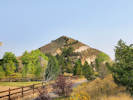 Dakota Ridge from the Cul-de-sac at the end of Jesse Lane. |
Literature Cited:
- Fernandez-Mazuecos, Mario, Jose Luis Blanco-Pastor, and Pablo Vargas, 2013.
- Sutton, D. A., 1988.
Other articles:
• Golden Checklist Flora:
Linaria canadensis texana;
• Field Notes:
Coll. No. 2077, 14 Jun 2019;
9 May 2020;
Locations: Dakota Ridge. Rocky Flats. White Ranch Park.
There is no historic botanic data for Dakota Ridge. The author made about 54 collections in 2020, and combined with additional observations, there are 86 plant species known from the ridge and adjacent gulch.
One collection is of particular interest. It is Linaria canadensis (L.) Dum.-Cours. Var. texana (Scheele) Pennell, with a common name of “Blue Toadflax.” A commonly used synonym for this plant is Nuttallanthus texanus (Scheele) D. A. Sutton. This name was proposed by Sutton (1988) to separate the new world Linaria from the old world Linaria. However, recent phylogenetic work (Fernandez-Mazuecos, et al., 2013) shows that the new world plants need to be retained in the old world genus Linaria. There is historic collection made along the railroad tracks in Golden from more than a century ago. More recently, it was collected at Rocky Flats and White Ranch.
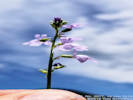 Coll. No. 2077, Linaria canadensis var. texana |
Other articles:
• Salvia Street:
Tony Grampsas Memorial Sports Complex;
Locations: Tony Grampsas Memorial Sports Complex.
The Tony Grampsas Memorial Sports Complex comprises 58 acres, almost entirely developed.
The City of Golden acquired the land now known as Tony Grampsas Memorial Sports Complex from Jefferson County Open Space in 1999. Coors Brewing Company originally developed the park for company softball tournaments, and, in 2000, the 63-acre park was named after Tomy Grampsas, a former Coors employee and strong advocate for parks and recreation in the State Legislature. Today, the park provides a location for several unique City of Golden amenities including softball fields, a gymnasium, a dog park, archery range, a mountain bike park, and, most recently, four new pickleball courts.
Other articles:
• Field Notes:
7 Dec 2024;
Locations:
Grampsas North.
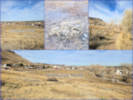 Composite photo of Grampsas North Open Space.
Composite photo of Grampsas North Open Space.
The Grampsas North Open Space is a rectangular field about 6½ acres in size that is north of the mountain bike park. It is fenced on three sides. The west side is bounded by rural housing and several neighbors who came out for a friendly conversation. The north side has a recent housing development. The east side is bounded by the Church Ditch and the Tony Grampsas Trail, which lines both sides of the ditch. There are cottonwood trees along the ditch. There might some opportunity for enhancement (I really don’t want to say “development”) of the trail along the Church Ditch, somewhat like the work of the High Line Canal Conservancy.
The vegetation of Grampsas North is western great plains grassland. The plants present are about 2/3 common Golden natives and about 1/3 weeds, a proportion typically seen around Golden. There are a few noxious weeds. I found a few of the uncommon “Dwarf Rabbitbrush” — Ericameria nauseosa var. nauseosa. It is not really a dwarf, just a naturally small plant. It’s big brother that I like to call “Goldy-Locks,” variety graveolens, is also common in Grampsas North. Both of these prairie plants were first scientifically described from collections by the Lewis & Clark Corps of Discovery in 1804-1806. A small thicket in the center of Grampsas North has hackberry, chokecherry, and American plum, though none of them are large enough to make shade.
There are the usual deer and elk signs (i.e., poop), and I scared up a few rabbits. The neighbors told me they frequently see hawks in the cottonwood trees, probably eyeing the rabbits and squirrels for dinner.
The view from Grampsas North is the east side of North Table Mountain with numerous mountain bikes and parties of hikers on a pretty fall afternoon.
There two challenges will have in managing Grampsas North as Open Space.
Grampsas North is not the perfect little open space we typically think of when we talk about open space, but perhaps it presents an opportunity to set aside some of our land for the animals and some quiet contemplation. How it develops through the master plan process will be interesting. Go have a look at Grampsas North and prepare your thoughts for the master plan team.
Locations: Coors Tech Wetlands.
Coors Tech Wetlands Open Space (8.34 ac.) is the largest wetland area owned by the City of Golden, located west of McIntyre Street between Table Mountain Parkway and 50th Avenue. The wetland includes a cattail pond and other water-loving plants, with water draining frm surrounding streets and possibly additional sources. While there are no formal trails, some social trails exist near the Montessori schol and McIntyre Street. The wetlands attract a variety of wildlife, including red-wing blackbirds, and have potential as an educational resource for nearby schls and Golden residents, emphasizing the ecological importance of wetlands and local wildlife.
Literature Cited:
- Anonymous, n.d..
- White, Sally L., and Margaret Chapman, 2014.
Locations: Tucker Gulch (lower).
Tucker Gulch and the lower part of Cressman Gulch, i.e., south and east of Colorado Highway 93, form a kind of linear open space, if the term “open space” can be applied to a long narrow shape. While much of the lower part of Tucker Gulch is still railroad right of way, the portion owned by the City of Golden is 34 acres. Tucker Gulch between the highway and Clear Creek is about 3.2 km. in length, and Cressman Gulch from the highway to the mouth at Tucker Gulch is about 1.5 km. in length. When combined with the railroad land, the width varies from a minimum of 17 m. to a maximum of 109 m., although generally the width is about 30 to 50 m.
Tucker Gulch is named after Alfred Tucker who moved with his wife to Golden in 1859 from Illinois. It originally included a toll road and a railroad, but now it is reduced to a long narrow linear space between Golden neighborhoods. The city-owned portion of Tucker Gulch from Clear Creek up to Colorado Highway 93 is about a mile and a quarter in length, while the width varies from 50 to 275 feet. The total area is about 21 acres in 18 to 29 separate parcels of land, depending on how one counts.
Tucker Gulch has an important Public Works function as a flood channel draining Golden Gate Canyon and, to a lesser extent, Cressman Gulch. It has been the scene of eighteen recorded floods between August 1, 1869, and most recently May 7, 1973 (Anonymous, n.d.; White and Chapman, 2014). Tucker Gulch is also a convenient place for utilities serving adjacent neighborhoods, such as water and sewer lines, and it contains both, though they are well disguised.
Cressman Gulch is about 5.9 acres in size and made up of 8 parcels of land that are typically 50 to 75 feet in width. Primarily used for flood control, utilities, and drainage, there is also a city-owned concrete trail along part of Cressman Gulch.
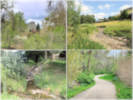 Composite photo of Tucker Gulch. |
Tucker Gulch, especially, also has some attractive recreational values. The Tucker Gulch Trail winds alongside a perennial stream aligned with groves of established trees, shrubs and grasses. There are numerous access points: 7th Street, 1st Street, North Ford Street (at Norman D. Park) and Mesa Drive. There is little traffic noise providing trail users with a peaceful nature experience. The wider parts of Tucker Gulch have places for peace and solitude. Birds and wildlife are common in Tucker Gulch. Bears, moose and, sometimes, mountain lions are reported in Tucker Gulch on social media. On a recent morning, a friend and I saw an 8-point buck just north of 1st Street, and a pair of flickers feeding on the ground beside the trail.
Other articles:
• Tucker Gulch Trail:
above First;
• Field Notes:
Coll. No. 1334, 11 May 2016;
The vegetation in Tucker Gulch is quite weedy. There are only a few collections made in Tucker Gulch and of them only one is native: Heterotheca villosa “Hairy False Goldenaster.” Among the non-native plants, one, Alopecurus arundinaceus “Creeping Meadow Foxtail” is an uncommon grass in Jefferson County, and therefore at least mildly interesting.
Like a lot of places in Golden, Tucker Gulch and Cressman Gulch have their problems with weeds, yard waste disposal, and social trails, which do not negate the recreational value of the gulches.
At North Ford Street, the Tucker Gulch Trail passes through Norman D. Park where there is water and a restroom (OK … a Port-A-Potty). As it happens, the city’s land also includes a strip on the north side of the creek that is 50 to 100 feet wide. This strip was originally planned for a street connecting Golden Gate Drive to Mesa Drive. Since this connecting street has never been constructed, perhaps it could be added to the open space in Tucker Gulch.
Neither Tucker Gulch nor Cressman Gulch are typical plots of land that one thinks of as “open space.” Neither are they parks. But they both have significant recreational values in addition to Public Works purposes. It seems to me that our Open Space Master Plan needs to acknowledge these linear open spaces and define how our Public Works and Parks & Recreation departments jointly manage them for our present and future enjoyment.
Other articles:
• Social Trail (N. Wash. OS):
at top;
near top;
• Nightbird Gulch Trail:
at point;
• North Table Mountain Trail:
at social trail;
• Field Notes:
25 Mar 2017;
Coll. No. 1614, 15 May 2017;
Locations:
Schweich Hill.
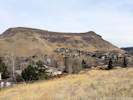 View west to North Table Mountain.
View west to North Table Mountain.
The little piece of City of Golden open space at the north end of Washington Avenue, near Cannonball Creek Brewery, measures 4 acres. Tracts A & B of the parcel was accepted by the City of Golden by Resolution No. 516, adopted December 23, 1993. Both tracts are dedicated as open space, although Tract B was also dedicated for W470 expansion.
A small portion covering the top of the hill, about 1.5 acres in size, could be identified as Western Great Plains Foothill and Piedmont Grassland with mixed tall and short grass species. Significantly sized other portions, would be identified as Smooth Brome (Bromus inermis Leyss) Ruderal Vegetation.
There are 136 taxa (species of plants) in 42 plant families, mostly grasses and forbs (non-woody perennials). None of the plants collected or observed are Colorado-ranked rare plants (Colorado Natural Heritage Program, 1997+). There are 13 species of Colorado-listed Noxious Weeds (Colorado Department of Agriculture, 2014-2019). There is one species on List A, Euphorbia myrsinites L. “Myrtle Spurge,” and seven List B species. At least one species of noxious weed, Dipsacus laciniata, has not been seen for several years due to repeated weeding.
There is substantial disturbance around the edges of the parcel. Disturbance includes grading, water lines or other utilities, construction, landscaping or revegetation, yard debris disposal and mowing by neighbors, and social trails and amenities. It is unclear when the water line was placed across the parcel, but the current vault appears in 7/4/2005 imagery. The center of the open space is less-disturbed, where the primary disturbances are social trails and amenities.
There are four easily identifiable social trails crossing all or part of the parcels. The primary social trail crosses the parcels east to west across the top of the hill. This trail bisects the area of remnant native vegetation on the top of the hill and is frequently used by hikers, dog walkers, and by a few mountain bikes. The opportunities for rerouting this trail away from the native vegetation, while still permitting access to the top of the hill, seem quite limited. The trail is eroding on the stepest slope at the eastern slope of the hill. There is one social amenity, i.e., a bench near the top of the hill. The bench and associated access trail first appear in 10/7/2012 imagery. The access trail to this bench passes perilously close to several individual plants of Missouri Foxtail Cactus.
The top of the hill is occasionally used for picnics or similar activities as evidenced from a rather large trampled area. I have even encountered a wedding photography party on top to the hill. Unfortunately, the trampled area is at the center of the best native vegetation. This causes damage to the small area of native prairie and indicates why the trail needs to be signed with a plea for users to remain on the trail.
Field trips sponsored by Colorado Native Plant Society visited the open space parcel in 2018 and again in 2022.
I keep a separate report about this open space, which can be found on my home page with a title of “Botanical Resources of Schweich Hill, Golden, Colorado.”
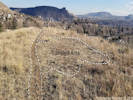 Trampled area beside social trail. |
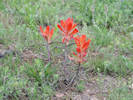 Coll. No. 1614, Castilleja integra, along the top of the Schweich Hill. |
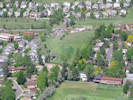 Schweich Hill as seen from North Table Mountain |
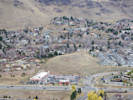 View of Schweich Hill from Mount Galbraith |
Locations: Grant Terry Open Space.
The City of Golden owns 3.59 acres along the north side of Clear Creek and south of US 6. The land is adjacent to Jefferson County Open Space’s Peaks to Plains Gateway Trailhead. This Open Space is bisected by the 0.6 mile Grant Terry Trail that ends at the Church Ditch headgate. Along this trail, there is a set of stairs leading up to Jefferson County Open Space’s Peaks to Plains Trail, which is now being rebranded as the "Clear Creek Trail." The open space is characterized by being heavily vegetated with established trees, shrubs, and grasses.
Although the Grant Terry Trail is close to US Highway 6 and there is an active use of the Peaks to Plains Trail by hikers and cyclists, there is still a good nature experience for trail walkers due to the sounds and sights of Clear Creek. Adding to the experience is the scenic views of the towering geology of the Foothills. At night, it is quite possible that the trail is used by local wildlife.
Other articles:
• Chimney Gulch Trail:
at pkg;
• U. S. Highway 6:
at pkg;
Locations: Lower Chimney Gulch.
The hang glider landing field is 45 acres, property owned by Colorado School of Mines, a lot of it disturbed by use. To the south of the landing field is a small City of Golden parcel of about 14 acres.
Other articles:
• Social Trail (Parfet Estates Drive to Landing Zone):
near Parfet Estates Drive.;
Locations:
Parfet Open Space.
Welch Ditch.
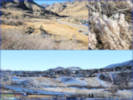 Several photographs of Parfet Open Space.
Several photographs of Parfet Open Space.
The City of Golden owns about 14 acres of open space that wraps around the north end of the Parfet Estates neighborhood and overlooks US Highway 6. The land is bordered by the neighborhood, US Highway 6 right of way and Colorado School of Mines land that contains the Chimney Gulch Trail.
Golden acquired this property as part of the Parfet Estates Subdivision in 1994 for “… streets, open space, utilities, and drainage …” It was designated “Parfet Open Space Park” by City of Golden Resolution No. 1573 in 2005. (This is different from Parfet Park at the corner of Washington Avenue and 10th Street.)
While the defunct Welch Ditch crosses this land, the only other “facility” found on city land is a windsock to help the parasailers land safely.
An unmarked trailhead on Parfet Estates Drive leads to a social trail from the neighborhood down to the Chimney Gulch Trail located on Jefferson County Open Space land. This trail continues upward to Windy Gap and Lookout Mountain.
Other articles:
• Golden Checklist Flora:
Krascheninnikovia lanata (Pursh) A. D. J. Meeuse & Smit.;
Parfet Open Space contains a mix of disturbed and undisturbed land with some remnants of native vegetation, notably Winter Fat. Winter Fat — Krascheninnikovia lanata (Pursh) A. D. J. Meeuse & Smit. — is named after Stepan Krasheninnikov, 1711-1755, a Russian botanist, professor in Saint Petersburg, and explorer of Siberia and Kamchatka in the early 18th century. The genus is the Chenopodiaceae, the Goosefoot family, which comes from the Greek words "chen" meaning "goose" and "pous" meaning "foot," because the leaves are often shaped like a goose foot. This family is interesting to me because they show the biogeographical connection of western North America to the steppes of eastern Eurasia.
There are abundant signs (i.e., poop) of elk and other large mammals in Parfet Open Space Park, though seeing them may be uncommon because of the adjacent busy highway.
From the site, there are excellent scenic views of the Rocky Mountain foothills, North and South Table Mountains, and north through Golden Valley.
Other articles:
• Lookout View Court:
32460;
• Lubahn Trail (north loop):
at trailhead;
• Ridge Road:
near N Easley Wy;
• Rimrock Drive:
on Rimrock Dr;
• Golden Hills Road:
at trl hd;
• Kilmer Street:
10000;
Locations:
South Table Mountain.
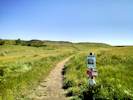 Golden Hills Trailhead
Golden Hills Trailhead
Seen from a distance, it is clear the upper surface South Table Mountain is a continuation of the upper surface of North Table Mountain.
Ownership of South Table Mountain is more mixed than North Table Mountain. The three largest owners are Jefferson County (738 Ac.), State of Colorado (500 ac.), and Bear Creek Development (312 ac.). The City of Golden owns a small 31-acre parcel where the Lubahn Trail is found.
There are three developed trailheads with parking, two access points without parking, and three more informal, or social, access points.
Trailheads with parking, often just street parking are at:
Neighborhood access without parking is at:
 Castle Rock from Lubahn Trail trailhead |
 Map of South Table Mountain |
Other articles:
• 6th Avenue Trail:
31500;
• Field Notes:
30 Apr 2025;
Locations:
Parfet Prehistoric Preserve.
Triceratops Trail.
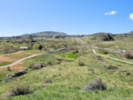 South end of Parfet Prehistoric Preserve.
South end of Parfet Prehistoric Preserve.
The Parfet Prehistoric Preserve (14.08 ac.) is a culturally and scientifically significant site located near the western edge of Golden. The preserve is one part of the Morrison-Golden Fossil Areas National Natural Landmark and includes outcrops of the fossil-rich Dakota Sandstone Formation, with evidence of prehistoric plant and animal life, including dinosaur tracks and invertebrate fossils. Together, these sites highlight the geological and scientific importance of the area.
Within the preserve is Triceratops Trail, an interpretive path that showcases visible fossilized tracks and impressions, offering a unique opportunity for public engagement with Golden’s paleontological history. The trail is managed by the Friends of Dinosaur Ridge in partnership with Golden and the Friends of Fossil Trace.
There are scenic views of surrounding ridgelines and rock outcroppings, though adjacent US Highway 6 is really noisy, making a field discussion difficult. While public access to the preserve itself is limited, it remains an essential component of Golden’s heritage landscape and a priority for long-term preservation.
Parfet Prehistoric Preserve was not originally included in the list of City of Golden Open Spaces. However, discussion with members of the Parks and Recreation Advisory Board and the Open Space Working Group led to its inclusion.
Other articles:
• Welch Ditch:
near boundary;
• Field Notes:
2 Jan 2025;
Locations:
Cottonwood Natural Area.
 View to southeast from Welch Ditch across Cottonwood Natural Area.
View to southeast from Welch Ditch across Cottonwood Natural Area.
The Cottonwood Natural Area was dedicated to the city for “… public open space and drainage …” by the Harmony Village Plat, filed December 5, 1995. The Harmony Village plat created both Harmony Village and the adjacent Cottonwood homes. Each of those neighborhoods have their own private open space in addition to Cottonwood Natural Area that is public open space.
Tucked between Golden High School, Fossil Trace Golf Course, and surrounding neighborhoods, Cottonwood Natural Area feels like a hidden gem. While landlocked and lacking convenient public access, the area serves as a quiet refuge. Remarkably, when you combine the public and private open spaces with a golf course surge pond, you end up with about 6½ acres of natural land nestled amidst urban development—a surprising patchwork of greenery in an otherwise busy setting.
Cottonwood Natural Area is crossed on the northwest side by both the Welch Ditch and Kinney Run, so there is probably perennial water in the natural area to attract wildlife.
To be sure, Cottonwood Natural Area is quite weedy, with some listed noxious weeds, like White Top (Lepidium draba L.) and Scotch Cottonthistle (Onopordum acanthium L.). There is also Chinese Desert-Thorn (Lycium chinense Mill.), one of several species sometimes called “goji berry.” Like some of its relatives, Chinese Desert-Thorn has the potential to be invasive.
On the other hand, there are still quite a few native plants, such as my favorite “Goldy Locks,” though the rest of the world calls it rabbitbrush (Ericameria nauseosa var. graveolens). There are, of course, established cottonwood trees (Populus deltoides Marshall), with hawthorns (Crataegus sp.), coyote willows (Salix exigua Nutt.), and more.
Meadow vole tunnels crisscross the vegetation, hinting at a small mammal population that probably also includes mice, rabbits, raccoons, and the like. It's easy to imagine deer and elk wandering through, and very likely a predator or two in the brush or up in the trees.
With its mix of established trees, open terrain, and diverse flora and fauna, this little pocket of open space remains an unexpected yet valuable retreat amidst Golden's urban landscape.
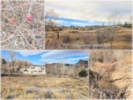 Composite photo of Cottonwood Open Space in December 2024. |
Other articles:
• Illinois Street:
near end;
• Field Notes:
4 Sep 2024;
Locations:
South Illinois Open Space.
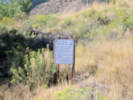 Sign for South Illinois Open Space
Sign for South Illinois Open Space
The city owns 0.32 acres of neighborhood urban open space that is located at the east end of the public vehicle access on Illinois Street. The east side of this open space includes a small piece of the city owned Fossil Trace Golf Course.
Acquisition of this city land was spearheaded by the residents of Harmony Village. They recognized the unique 360° scenic views from the top of the knoll on the property. The resident group was able to get the housing developer to offer the parcel at market value to the city and the Harmony Village residents contributed landscaping improvements. There is a short, winding dirt trail to the top of the knoll.
Non-native grasses grow on the site. City water is available. No formal vegetation assessment of this open space has been conducted. Residents report seeing the Golden elk herd in the winter as well as coyotes and some birds.
The Open Space is located just east of the actively mined area of what used to be the Rockwell Clay Mine, operated by the Parfet Family. It sits on the geologic unit called the Arapahoe Formation, a river-formed conglomeratic unit that represents the very first uplift of the Rocky Mountains farther to the west, in late Cretaceous geologic time (around sixty-eight million years ago).
Various parts of the mine area, especially near the Triceratops Trail, were opened around 1900. After WW II, the mine expanded into the area of what are now fairways of Fossil Trace Golf Course, just to the immediate west of the park. Being able to buy surplus WW II equipment like the steam shovel still scattered across the golf course, made it possible to do open pit mining. The clay was used for brick and sewer pipe. The Rockwell Mine operated until about 2002 when the area was transferred to the City of Golden for the golf course.
The Rockwell Clay Mine area is located within the slightly older Laramie Formation, which was a coal swamp in a delta, much like in Louisiana today. Dinosaurs once roamed the landscape.
The knoll is above the roof tops of nearby homes which allow for views of the Foothills, and North and South Table Mountains. As reported by the residents, the site is a good place to view the night sky.
This urban open space provides a sense of place. As reported by a resident, it is a place where there is quiet, and one can sit and be alone to contemplate and just enjoy the outdoors.
Other articles:
• Lubahn Trail (South Loop):
above rim;
• Field Notes:
Wednesday, October 15th;
4 May 2020;
Locations:
Apex Park.
Lookout Mountain.
Matthews/Winters Park.
Windy Saddle Park.
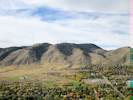 Lookout Mountain
Lookout Mountain
Lookout Mountain is the very eastern edge of the Rocky Mountain Front Range. The Front Range runs north-south between Casper, Wyoming and Pueblo, Colorado and rises nearly 10,000 feet above the Great Plains. Longs Peak, Mount Evans, and Pikes Peak are its most prominent peaks, visible from the Interstate 25 corridor. The highest mountain peak in the Front Range is Grays Peak. Other notable mountains include Torreys Peak and Mount Bierstadt.
Only the eastern-facing slopes of Lookout Mountain are covered by this checklist flora.
Land ownership (1,221 ac.) is primarily Jefferson County Open Space for Windy Saddle Park, Apex Open Space Park, Lookout Mountain Nature Center, and small portion of Matthews/Winters Park. Denver Parks owns a large parcel (69 ac.) on top of Lookout Mountain. Martin Marietta is the largest private landowner for their quarry, followed by the Missionary Sisters of the Sacred Heart (Mother Cabrini Shrine).
Other articles:
• Field Notes:
Wednesday, July 6th;
Locations:
Colorado School of Mines Survey Field.
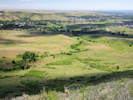 South end of Survey Field, south Golden, and South Table Mountain.
South end of Survey Field, south Golden, and South Table Mountain.
The next largest single parcel is the Colorado School of Mines Survey Field. It consists of 2 parcels totaling about 226 acres. At the upper, west side, it abuts Lookout Mountain.
Though owned by a public agency, the Survey Field is not really open to the public, in the sense of a public park or open space. The school needs to know who in on their property, and to cover themselves for liability issues.
The Survey Field has been disturbed by roads, mining, and utilities. It is also quite weedy in places. Regardless, it is a unique piece of open space in Golden, given its size, and its place between Golden and Lookout Mountain.
Other articles:
• Golden Checklist Flora:
Kinney Run South;
• Kinney Run Trail:
at rock knob;
• Field Notes:
16 May 2018;
Locations:
Eagle Ridge.
Kinney Run.
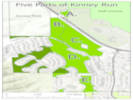 The five parts of Kinney Run.
The five parts of Kinney Run.
The Kinney Run area is Golden's second-largest Open Space, after North Table Mountain. The City of Golden-owned parcels are about 86 acres in size. The landscape is quite varied, including riparian, prairie, shrubland, slick rock, and a hogback. The area generally known as Kinney Run was assembled in four events.
The earliest event was the acquisition of the area sometimes called Kinney Run South in 1996. This was the Tripp Ranch Filing No. 1.
The main part of this open space came into city ownership by way of Eagle Ridge - Filing No. 1, August 24, 1998. Tracts A, B, C, D, E, F, G, H, and I, were dedicated to "the City of Golden under the Kinney Run and Eagle Ridge vested rights development agreement." City Council Resolution 1573, 9 June 2005, recognized "The unique geologic areas in the Eagle Ridge area (including the Dakota hog back, Cambria Lime Kiln, Kinney Run Trail, and riparian areas) are hereby designated as a geologic and environmental education park."
A small (1.73 ac.) triangular parcel squeezed between Illinois Street and US Highway 6 was acquired in June 2003, for the sum of $175,000.
A smaller part of about 8 acres on the southeast side of Eagle Ridge was acquired April 13, 2011 from Eagle Ridge Lunnon, LLC, as part on Eagle Ridge Center Filing No. 3.
Of the four names applied to this area, only two: Deadman Gulch and Heritage Dells, are recognized by the U.S. Board on Geographic Names (BGN, n.d.). Kinney Run and Eagle Ridge are local names. The source for “Kinney Run” is unknown, but is probably a euphemism used by developers for Deadman Gulch. The original source may be “Kenneys Creek” found on the 1938 Morrison quadrangle applied to a creek flowing north along present-day Johnson Avenue, then northwest along South Golden Road. Similarly, the source for “Eagle Ridge” is also unknown, but was probably chosen by real estate developers in the area.
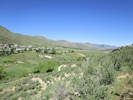 View generally north of Kinney Run. |
Locations: Deadman Gulch. Eagle Ridge.
There are five distinct parts to the Kinney Run Open Space, seen in the map above. Part A is a small triangular parcel that is north of US Highway 6. This is mostly forested with the channelized stream of Kinney Run running down one side.
Part B is a remnant of prairie wedged in between Eagle Ridge, US Highway 6, and the Survey Field. I use the name of Kinney Run Prairie for this part.
Part C is the hogback locally known as Eagle Ridge. It is a distinct landform not found elsewhere in Kinney Run.
Part D is the riparian valley of Kinney Run, sometimes referred to as Kinney Run North, to distinguish it from Kinney Run South, below.
Part E is the southern part of Kinney Run Open Space that was acquired aa part of the Tripp Ranch Filing No. 1 in 1996. I generally refer to this as Kinney Run South, which is discussed at length below.
There is very little biological information about Part A, though there are collections of Rhamnus cathartica and Solanum dulcamara, and observations of Epilobium hirsutum. There is loud traffic noise from US Highway 6, just above this parcel, which is not conducive to tarrying here.
Part B, Kinney Run Prairie appears to be alluvial from a distance, but walking it shows that some of the substrate is bedrock aligned with Eagle Ridge to the south. This creates drier, more coarse soil and a thin, slightly different vegetation.
Part C, Eagle Ridge has prairie down by US Highway 6, shrublands on the steep slopes and nearly bare soil along its spine. I have found a few interesting things on Eagle Ridge, such as Holodiscus discolor on steep northeast-facing slopes, and a hops, probably Humulus lupulus, in one of the old mining pits. A lower slope in the north has our uncommon variety of rabbitbrush, Ericameria nauseosa var. nauseosa. The southern end of the ridge, where the Centura Urgent Care is now, was the site of a number of Handsford T. Shacklette collections. These were made near the intersection of US Highway 6 and Heritage Road (June 27, 1959. 25 vouchers, COLO, and 1 voucher, MICH).
Other articles:
• Kinney Run Trail:
at sm. hill;
at coll locn;
• Field Notes:
Coll. No. 1780, 12 Apr 2018;
Coll. No. 1783, 12 Apr 2018;
Locations:
Cambria Lime Kiln.
Kinney Run.
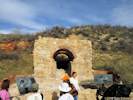 Cambria Lime Kiln
Cambria Lime Kiln
South and west of Eagle Ridge is the heart of Deadman Gulch/Kinney Run. A little over 31 acres, this parcel is oriented north-south, and fairly narrow from east to west.
The northernmost portion has been revegetated. The Cambria Lime Kiln is found in this parcel. There is road frontage in two places on Eagle Ridge Drive, and one place on Crawford Street. The Kinney Run Trail, a concrete multi-use trail bisects the parcel from north to south.
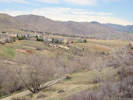 Kinney Run in early Spring. |
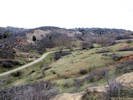 View of Kinney Run in early Spring. |
The vegetation of Kinney Run is a mosaic of Foothills Shrubland and Riparian, with some remnant Mixed-Grass Prairie. Despite the extensive disturbance and planting of non-natives, many native grasses and forbs (non-woody perennials) can still be found in Kinney Run. Roundtip Twinpod (Physaria vitulifera) and Front Range Beardtongue (Penstemon virens) bloom in the spring on the rock outcrops of the Lyons Sandstone along with Mountain Mahogany (Cercocarpus montanus). Green Needlegrass (Nassella viridula) and Needle and Thread (Hesperostipa comata) are found around the edges of the Chokecherry (Prunus virginiana) thickets below the cliffs. The wetter areas near the creek support both Golden Currant (Ribes aureum) and Wax Currant (R. cereum), along with Wild Bergamot (Monarda fistulosa) and the Cloaked Bulrush (Scirpus pallidus). The drier slopes opposite Eagle Ridge support many examples of remnant Prairie vegetation, such as Prairie Groundsel (Packera plattensis), Cowboy Delight (Sphaeralcea coccinea), and Blanketflower (Gaillardia aristata).
Literature Cited:
- Haddad, Nick M., et al., 2015.
- Steadman, Christy, 2019.
Locations: Kinney Run.
Letters: Thursday, August 9, 2018.
Golden GiddyUp (2017-2018) proposed to build a system of dirt bicycle trails in the Kinney Run/Heritage Dells area, including one through this parcel. The trail was proposed to be some distance away from the existing Kinney Run trail. It would therefore further fragment this small area into three pieces from its current two pieces. This proposal was strongly opposed by the Friends of Kinney Run, and by the author. This proposal has been withdrawn, for now, in favor of a bicycle trail linking Beverly Heights to Kinney Run, by way of the Survey Field.
Locations:
Kinney Run South.
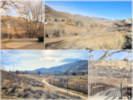 Composite photo of Kinney Run South.
Composite photo of Kinney Run South.
Between Tripp Ranch and Heritage Dells Park lies a small parcel of 7.8 acres. This parcel goes from the riparian zone of Kinney Run east to the back fences of the houses that face Somerset Street.
Kinney Run South is a middle-size open space, as Golden open space goes, that is squeezed in, east to west, between the Lakota Hills neighborhood and Shelton School and, north to south, Tripp Ranch and Heritage Dells Park.
The largest part of Kinney Run South, about 8 acres, was acquired by the city when the Tripp Ranch neighborhood was platted in early 1993 (Tripp Ranch -- Filing No. 1, February 25, 1993, Reception No. 93024873) It was known then as Tract C of Tripp Ranch and dedicated for “open space/drainage purposes.” There are some other little parcels, such as part of Tripp Ranch, Tract D, and part of Lakota Hills (1986) plat, Tract B that could be considered part of the Kinney Run South Open Space. If those spaces are included, then Kinney Run South is close to 10 acres.
The rocks of Kinney Run South are primarily Permian-age Lyons Formation, roughly 270-285 million years of age with alluvial deposits along the stream of Kinney Run. The cliffs in Kinney Run South are formed by Lyons Sandstone (Anderson & Haseman, 2021).
The plants in Kinney Run South are the common grasses and shrubs we find around Golden. There are two interesting plants found right up against the cliffs formed by the Lyons Sandstone. One of them is Rubus deliciosus Torr., the “delicious raspberry.” It was described from collections that Dr. Edwin James made in 1820 somewhere along the Front Range. The joke, of course, is that the delicious raspberry can be described as “insipid at best.”
While surveying the vegetation of Kinney Run with the Colorado Natural Heritage Program in 2021, Scribner’s Needlegrass —Eriocoma scribneri (Vasey) Romasch, was found in the soft soil at the base of the cliffs (Sovell & Panjabi, 2021). Kinney Run South is the only place this grass has been found in or near Golden. The nearest other collections are found at Rocky Flats and at Chatfield Farms, two of the most studied pieces of ground in Colorado.
Like other Golden open spaces, Kinney Run South has its problems. While walking in the open space I found discarded tree limbs, a dead bicycle, and a wheel-less desk chair, all apparently yeeted over the cliffs. [Def: yeet. v. To throw something forcefully, often with enthusiasm.]
Other articles:
• Golden Checklist Flora:
Kinney Run;
Even in dead of winter, the Kinney Run Trail is popular for a daily walk. Away from busy streets there is little traffic noise, and the open space is quiet, punctuated by the cheerful shouts of Shelton School students at recess.
Other articles:
• Kinney Run Trail:
near intersection;
• Field Notes:
Sunday, August 8th;
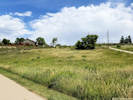 The southern part of proposed mountain bike trail, Segment 4.
The southern part of proposed mountain bike trail, Segment 4.
At the south end of this parcel, there was formerly a social trail from the end of W. 4th Avenue down to the Kinney Run Trail. Presumably this trail was used by children enroute to Shelton School. The trail is faintly visible on GoogleEarth imagery from 1999, before the concrete trail was constructed to the south. The social trail has since been revegetated (2015 to 2017).
Heritage Dells Park is accessible from Crawford Street. In 1987, this foothills park was built to serve the Heritage Dells Subdivision. Currently, it is located at the midpoint of the Kinney Run Trail, and makes for a great resting place along this regional trail that begins at Heritage Square. The terrain is hilly and it’s a “good push” to get a loaded baby stroller back to the car from the A.D.A. accessible playground. A basketball court is also available at the park, perfect for neighborhood pick-up games and practice. Includes a cherry stem southward to Kimball Avenue.
Locations: Heritage Dells.
The location of GNIS Heritage Dells. Roughly at the corner of Kimball Avenue and Crawford Circle.
Locations:
Heritage Dells.
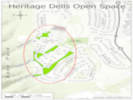 Location of Heritage Dells Open space.
Location of Heritage Dells Open space.
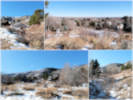 Composite photo of several gulches of Heritage Dells.
Composite photo of several gulches of Heritage Dells.
In south Golden, three parallel gulches form the Heritage Dells Open Space. Over thousands of years, water running off the southeastern sides of Lookout Mountain eroded away sediments to shape the sloped grasslands and gulches where the Great Plains meet the Rocky Mountains.
Two of the gulches were deeded to the city by the Heritage Dells subdivision and one by the Tripp Ranch subdivision. Together they establish the southern beginnings of Kinney Run.
In the late 1970s and early 1980s, Pulte Homes and other builders constructed homes adjacent to the existing gulches and dedicated them for drainage and open space. All three gulches begin in Apex Park. The southernmost gulch enters Golden between two houses on DeFrance Way, widens into a large gulch, and then passes under Crawford Court and into Heritage Dells Park.
The middle gulch enters Golden about 1½ blocks farther north on the west side of De France Drive. Passing under the street, water flows into a wide gulch also entering Heritage Dells Park. At this point, the two gulches join to form Kinney Run. Significantly, a lot of rain and snow melt in the neighborhood also flows into the gulches due to the sloped hillsides.
The northernmost gulch enters Golden through a culvert under DeFrance Drive and forms a medium-sized gulch between Tripp Ranch houses. Passing under Shelton School, it joins the other gulches just below the Kinney Run Trail bridge.
Gravels and clays in the gulches help to clean both surface and subsurface water and support trickles of water in dry seasons that often go unnoticed yet support diverse vegetation.
The grass and shrubs in the gulches are common Foothills shrubs and mixed grass prairie. However, there have been no biological surveys of the gulches, so it is not known if rare plants may be present.
All three gulches provide wildlife habitat and corridors for both hunters and prey. Over the years, species such as white-tailed deer, elk, bobcat, fox, mountain lion, coyotes, bull snakes, garter snakes, and rattlesnakes, as well as an occasional brown bear, have been observed in the neighborhoods. Additionally, there are a variety of rabbits, brown bats, and birds.
There are no trails through these three gulches, although the original plat for Heritage Dells calls for an equestrian trail through the south gulch. The main trail in the area is the Kinney Run Trail, and parts of the gulches can be seen from this trail.
For residents, these gulches provide visual and physical open space buffers and collectively serve as neighborhood open spaces, which are shown to be important for personal health and for the movement of wildlife.
The Kinney Run trail continues south through a narrow corridor to Apex Park (Jefferson County Open Space) and its many trails. It passes by the Magic Mountain archeological site.
Literature Cited:
- Brunquist, E. H., 1966.
Locations: Magic Mountain.
Named for a nearby amusement park now known as Heritage Square, the Magic Mountain Archaeological Site south of Golden was excavated in 1959–60 by Cynthia and Henry Irwin. Because it was one of the first foothills sites to be professionally excavated, the Irwins’ report on Magic Mountain has provided the foundation for all later archaeological research in the region. In the 1990s new excavations discovered thousands of artifacts and bone fragments as well as several architectural features, which have helped provide more precise dates and cultural affiliations for the site. Vegetation in the vicinity of the Magic Mountain archeological site was surveyed by Ernest H. Brunquist (1966).
Other articles:
• Poco Calle:
at trailhead;
• Cty Rd 93:
at Apex Park;
• Field Notes:
25 April 2020;
6 May 2020;
Locations:
Apex Park.
Apex Park - Northern Parcel.
Deadman Gulch.
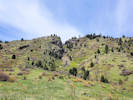 Deadman Gulch in Apex Park.
Deadman Gulch in Apex Park.
Apex Park is about 700 acres. Of those, about 500 acres are within the City of Golden. The larger southern portion of the park is heavily used and a popular destination for hiking and mountain biking. There is a smaller northern portion of the park that is closed for resource protection.
There is one trailhead and two other access points to Apex Park. The trailhead is on Heritage Road near Colfax Avenue. The access points are on Lookout Mountain Road and Poco Calle Road. They have minimal parking and no facilities.
Some clever map-reading will disclose other ways to enter Apex Park. However, doing so is difficult without crossing private property or inadvertently entering the restricted area.
Literature Cited:
- Anderson, Donna S., and Paul B. Haseman, 2021.
Other articles:
• Cty Rd 93:
at US 40;
• Rooney Road Sports Complex Road:
at end;
• Field Notes:
30 April 2020;
• US Hwy 40:
at Zeta;
• Interstate 70:
at cut;
Locations: Tin Cup Ridge.
Tin Cup Ridge is the northward extension of Dinosaur Ridge into Golden. Interstate 70 cuts through Dinosaur Ridge and separates the two parts of the ridge.
The easiest way to access Tin Cup Ridge is from the Rooney Road Sports Complex.
At the south end, Tin Cup Ridge can also be accessed from the T-Rex Park and Ride Lot. And, for the truly intrepid, it is possible to access Tin Cup Ridge from the north, through the Wrigley's Chicago Bar & Grill parking lot from the intersection of Colfax Avenue and Zeta Street. It was necessary to use this entrance when the Rooney Road Sports Complex was closed because of the COVID-19 pandemic.
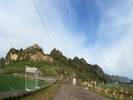 Panorama of Rooney Road Sports Complex and Tin Cup Ridge |
Locations: Matthews/Winters Park.
There is a small portion of Matthews/Winters Park that is north of Interstate 70, and just south of the Golden city limits. This area is not open to the public.
Literature Cited:
- Yeatts, Dick, and Loraine Yeatts, 2009.
Locations: Green Mountain.
There are a few lists available for Green Mountain. The most recent is Yeatts & Yeatts (2009).
Literature Cited:
- Van Horn, Richard, 1957.
- Van Horn, Richard, 1972.
- Van Horn, Richard, 1976.
Locations: Golden.
Literature Cited:
- Scott, G. R., 1972.
Locations: Golden.
Literature Cited:
- Chapin, Charles E., Shari A. Kelley, and Steven M. Cather, 2014.
- Hedgem Carl E., Robert S. Houston, Ogden L. Tweto, Zell E. Peterman, Jack E. Harrison, and Rolland R. Reid, 1986.
Locations: Dakota Ridge. Tin Cup Ridge.
Golden sits roughly in the center of the Rocky Mountain Front. This long, straight, persistent structural boundary originated between 1.4 and 1.1 billion years ago in the Mesoproterozoic Era. It was intruded by the Pikes Peak granite (1.09 billion years) in central Colorado. The Rocky Mountain Front began as a boundary between thick cratonic lithosphere to the east (modern coordinates) and an orogenic plateau to the west and remains so today. The structural boundary was reactivated during the breakup of the supercontinent Rodinia (1.1 to 0.6 billion years ago) and again during deformation associated with formation of both the Ancestral (≈300 Ma) and Laramide (80-40 Ma) Rocky Mountains. The landscape we now see was enhanced during the late Miocene to Holocene (ca. 6–0 Ma) by tectonic uplift. Increased monsoonal precipitation caused differential erosion along the mountain front, exhuming an imposing 0.5– 1.2 km escarpment that is bordered by hogbacks of Mesozoic strata and incised by major river canyons. The hogbacks do not occur in central Golden as they are cut off by the Golden fault. However, there are hogbacks in both north and south Golden s.l., i.e, Dakota Ridge in the north, and Tin Cup Ridge in the south.
Literature Cited:
- Weimer, Bob, 2001.
Locations:
Golden.
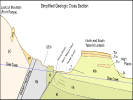 Simplified geologic cross section through Golden and vicinity
Simplified geologic cross section through Golden and vicinity
| ls | landslide | |
| Pf | Fountain Formation | Pink to reddish-orange arkosic sandstone and comglomerate, and dark-reddish-brown mudstone. |
| Tv3 Tv2 Tv1 | Lava flows. | Latite, dark gray, weathers light brown to light gray. Contains plagioclase, potassium feldspar, augite, olivene, and some biotite, magnetitem and apatite. |
| Tdv, Kdv | Denver Formation. | Light-gray to brown, lenticular, loosely cemented, tuffaceous sandstone, silty claystone, and andesitic conglomerate. System boundary based on paleontologic evidence. |
| Ka | Arapahoe Formation. | Light-gray to brown, quartzose sandstone and silty claystone; thick conglomerate locally at base. |
| Kl | Laramie Formation. | Light- to medium-gray quartzose sandstone and claystone, and several lenticular sub-bituminous coal beds in the lower 200 feet. |
| Kp | Pierre Shale. | Predominantly medium-gray clayey shale and some calcareous concretions, interbedded with some siltstone and silty sandstone. |
| peg | Granitic pegmatite | Dikelike, lenticular, and irregularly shaped bodies composed principally of quartz and microcline. |
| pC | Precambrian gneiss and schist. | Gray medium-grained gneiss consisting of quartz, plagioclase, and biotite. |
Literature Cited:
- Price, Alan B., and Alan E. Amen, 2008 rev..
Soils in the Golden area were enumerated in Price and Amen (2001, 2008 rev.). Seventy-nine different soil types are recognized in Golden sensu latu
Literature Cited:
- United States National Vegetation Classification, 2019.
Other articles:
• Field Notes:
19 Oct 2019;
Locations: Golden.
There are three basic types of vegetation in Golden s.l.:
I haven’t used formal names, such as those found in the National Vegetation Classification System (USNVC, 2019), because none of the areas in Golden s.l. have received the formal attention and documentation required for a more formal definition.
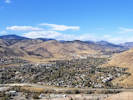 View similar to the historic view of Golden. |
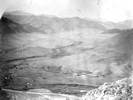 View of north Golden 1870-1880. Countesy of Denver Public Library. |
Shrubs are represented on the prairie by Ribes cereum (Wax Currant) and Prunus virginiana (Chokecherry).
In the watercourses, such as Tucker Gulch and Arapahoe Gulch, is a riparian vegetation consisting of willows and cottonwoods (Salix spp.), with sedges (Carex sp.) and rushes (Juncus sp.), and sometimes cat tails (Typha sp.).
Away from the valley bottoms, on the slopes of North and South Table Mountains and Mount Galbraith is a foothill shrubland. These can be very dry and exposed favoring Cercocarpus montanus (Alder-Leaf Mountain Mahogany). A little more mesic habitat favors shrubs such as Rhus trilobata (Squawbush) and Prunus americana (American Plum). The small watercourses may support Acer glabrum (Rocky Mountain Maple) and Physocarpus monogynus (Mountain Ninebark).
Of course, the boundaries between these vegetation types are rarely sharp, and representatives of one vegetation type will often be found growing with representatives of another type.
Date and time this article was prepared: 5/12/2025 2:46:14 PM